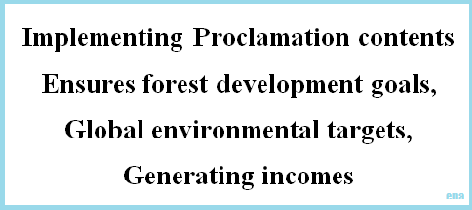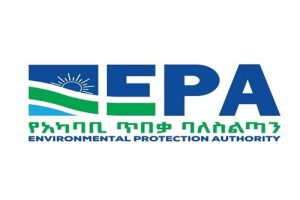
A legislative framework outlining the guidelines for the sustainable management of forests in a certain area or country is known as the Forest Development, Conservation, and Utilization Proclamation. Usually, it addresses issues including development, use, conservation, and forest preservation.
Ensuring that forests are maintained to balance environmental, social, and economic demands is the primary goal of such a declaration. This might involve taking action to stop deforestation, encourage reforestation, control logging, save biodiversity, and so on.
Since the proclamation provides a legal framework for the sustainable management of forests, ensuring that resources are used to meet current needs without compromising the ability of future generations to meet their own needs, planning and regulating forest development have several encouraging implications and are crucial for sustainable forest management.
The proclamation is also key to conserving the biodiversity of the country. Because it includes provisions for the protection of biodiversity within forests, ensuring the conservation of plant and animal species and their habitats. Furthermore, by regulating activities such as logging, mining, and land conversion within forested areas, the proclamation helps protect the environment from degradation and ensures the maintenance of ecosystem services such as water regulation, carbon sequestration, and soil conservation.
Nowadays, forest development supports the community on a socioeconomic level by outlining ways that local communities may sustainably profit from forest resources, including through revenue-sharing programs or community-based forest management efforts. Additionally, the proclamation lays out guidelines that organizations, companies, and government bodies engaged in forest management must abide by. To guarantee adherence to these guidelines, it also lays out enforcement procedures.
Besides, forest management by proclamation demonstrates the country’s international responsibilities. A Forest Development Proclamation that complies with international forest management agreements and conventions displays a country’s global commitment to sustainable development and environmental preservation. It is also essential for protecting the country’s biodiversity since it contains clauses that guarantee the preservation of plant and animal species as well as their ecosystems by protecting biodiversity inside forests. Furthermore, the proclamation guarantees the preservation of ecosystem services like water management, and soil conservation by prohibiting activities like logging, mining, and land conversion inside wooded regions.
More significantly, the proclamation discusses carbon sequestration—the technique of removing carbon dioxide (CO2) from the atmosphere and storing it to slow down global warming. This can be accomplished by technological means, such as carbon capture and storage (CCS) technology, or by natural processes, such as planting trees. Carbon sequestration lowers the atmospheric concentration of greenhouse gases and slows down global warming by taking CO2 out of the atmosphere and storing it in vegetation, soil, or geological formations.
Carbon sequestration plays an important part in Ethiopia’s attempts to combat climate change and promote sustainable land management practices. Ethiopia did its utmost to sequester carbon through afforestation and replanting, notably through initiatives like the Green Legacy Initiative. The country also employs agroforestry methods, which entail incorporating trees and shrubs into agricultural landscapes and are advocated in Ethiopia to improve soil fertility, biodiversity, and carbon sequestration. Farmers may improve their livelihoods and sequester carbon by planting trees on their farms.
In light of the significance and effects of carbon sequestration and forest development, the Council of Ministers examined and adopted the legislative frameworks of the “Proclamation of Forest Development, Protection, and Use” during its 27th regular meeting. This new proclamation is essential for the growth, preservation, and protection of Ethiopia’s forests as well as for putting legal restrictions on the country’s carbon sales. Furthermore, the proclamation seeks to advance fair use of forest resources for the benefit of current and future generations, sustainable forest management, and biodiversity protection.
According to the Proclamation, the forest sector plays a vital role in mitigating the negative consequences of climate change and promoting sustainable forest development, conservation, and exploitation. As a result, the Proclamation plays an important role in addressing environmental, social, and economic issues created by the country’s high degree of forest degradation. Furthermore, forest development, protection, and use have an important role in reducing soil erosion, desertification, and loss of biodiversity. The Proclamation also plays an important role in balancing demand and supply for forest products, supporting agricultural production, and guaranteeing food security.
Experts in the area also stated that the new forest development, conservation, and usage proclamation will make Ethiopia’s carbon sales legally binding and promote private sector participation. Furthermore, it enables the growth and conservation of Ethiopia’s forest resources by placing carbon stock into the world market and creating an economy that is not immune to climate change. It is also critical in growing Ethiopia’s forest resources and raising revenue from carbon sales.
Dr. Yitebitu Moges, Ethiopian REDD+ (Reducing Emissions from Deforestation and Forest Degradation) Program Coordinator, stated that there was no legal framework in place to conduct carbon sales in Ethiopia. However, the new proclamation will play a critical role in growing Ethiopia’s forest resources and raising revenue from carbon sales.
In addition, the legality of forest development, usage, and carbon sales has been considerably addressed by the proclamation that the Council of Ministers approved at its 27th regular meeting. Hence, the proclamation is important not only to expand forest resources and to obtain revenue but also to address the operational legality gap, he emphasized.
Ethiopia’s Forest Development Senior Forestry Specialist and the National Green Legacy Initiative Program Coordinator Dr. Adefires Worku said that the proclamation is imperative and appropriate to manage the actual results that are gained currently from forest development in a proper and legal system.
The new proclamation plays a vital role in promoting the industry’s growth and enhancing private-sector engagement. It is also critical for sustainable forest management and balances economic, social, and environmental demands. Besides, it, which includes provisions for biodiversity conservation within forests, serves to conserve Ethiopia’s unique flora and fauna, including indigenous species. This as a result will help the country to get additional income from carbon sales, he noted.
Indeed, preparing and approving the proclamation is critical for mitigating the harmful consequences of climate change through various measures because forests are important in climate change mitigation since they sequester and store carbon. The proclamation is also a significant step in demonstrating Ethiopia’s efforts to mitigate climate change via sustainable forest management.
Nevertheless, the government and the concerned bodies must firmly enforce the contents of the proclamation via strong commitment and institutional checks and balances. This, in turn, helps to achieve national forest development goals and global environmental targets while also generating considerable currencies from carbon sales.
BY EPHREM ANDARGACHEW
THE ETHIOPIAN HERALD TUESDAY 12 MARCH 2024




